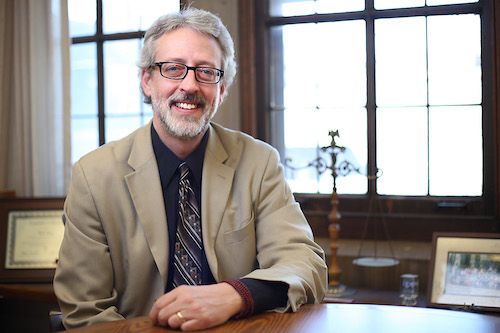
Over the past half-decade, the number of students enrolled in American colleges and universities has been fairly steady. But during that time, student demand for mental health services has spiked. Here at UM-Dearborn, in this academic year alone, we’ve seen a 20 percent increase in students seeking help from the Counseling and Psychology Services (CAPS) office. So what’s behind the sharp rise in demand? And more importantly, what’s the key to keeping up with students’ needs? Recently, UM-Dearborn’s CAPS Director Sara Byczek caught up with Todd Sevig, the longtime CAPS director on the Ann Arbor campus, for his take on these challenges. Here’s their conversation, which has been condensed and lightly edited for clarity.
Sara Byczek: So first, let’s talk about this increase in demand that we’re seeing. What do you think is behind this trend?
Todd Sevig: Well, I’ve been doing this work for 30 years, so one way to think about that question is to ask what’s really different between then and now. Obviously, there is a decrease in stigma around seeking help, which I think is a result of this huge increase in awareness of mental health throughout our society. There are so many programs in middle school and high school now. We see celebrities, high-profile athletes, actors, musicians actually talking about mental health. It’s in social media as well as traditional media. None of this happened in the past. So kids today are growing up with a really different experience of mental health, and when they grow up and come to our campuses, they’re much more open to using our services.
Concurrently, what’s been happening in counseling centers is that we’ve drastically increased the outreach part of our profession. I’m exaggerating a little bit, but in the old days, we’d basically sit in our offices and expect students to come in one at a time, we’d do counseling, and then we’d go home at the end of the day. Now, we’re doing workshops, we’re going to faculty meetings, we’re working with advisers, we’re online, we’re promoting knowledge of signs and symptoms, we’re talking about how to refer students. So we’ve focused a lot of energy on helping other campus personnel in their roles to support mental health.
The third thing I would say is there is a wild explosion of student interest and advocacy. They want their universities and colleges to do more with student mental health. They tend to love our counseling centers and they want more. The one fact I often share is that our students say the number one reason they come to our center is a referral from a friend. So that says a lot about how students view and value mental health services.
Sara: And given this changing landscape, what do you see as the big challenges facing counseling centers, and how do they compare with challenges from the past?
Todd: Well, I can share a little anecdote about that. The university is actually renovating the building where our counseling center on the Ann Arbor campus is located, and in the course of temporarily moving our offices, we’ve been going through old documents dating back to the early 1970s. We found memos written about “increasing demand” and “the need for more staff.” I mean, for the most part, we could simply put a new date on there and use the same text today.
So from a historical perspective, I think it’s almost ‘old news’ to simply say ‘there is an increase in demand and we need more staff.’ I don’t think that’s actually what’s relevant right now. I think the more relevant challenge is keeping in touch with new needs, and this means providing multi-faceted services for different groups of students. The core idea is that all students need mental health support, but not everyone needs individual therapy. So we need to be looking at group-based counseling; using technology to reach students who don’t interface with our office; workshops; peer-based approaches. In fact, when I first came into the profession, peer approaches were all the rage. Then somewhere in the mid-1990s, students decided they didn’t want to see their peers; they wanted to see professionals. And then in the past five or six years, enthusiasm for peer approaches has exploded again, albeit in a different way. So in that case, we’re looking at how we, as counseling centers, can provide training for peers, but then allow the peers to provide a whole bunch of services that some students really benefit from. That’s the opportunity, but to do it well, we have to be really good at listening to what students want and need.
Sara: That’s a great point. As you know, I love peer programs. Ours is in its second year, and the reason we started it is that students say they're more likely to talk with their friends. We’ve found in many cases, it really is better than any kind of service we can provide for them. But let’s go even beyond the context of our counseling offices. What do you think colleges as a whole could do to better support their students’ mental health?
Todd: That’s a great question. First, I do think it’s important that the staffing of counseling centers meets the needs — and importantly, that there’s diversity in our staffing. And yet, there are other things that colleges and universities can do. I actually had an opportunity recently to go to a class and talk with students about this exact topic, and they had some interesting suggestions. They talked about free yoga sessions, more wellness events, more conversations about mental health issues in the classroom, mental health days throughout the semester. But one thing they said that really stuck with me — and I don’t think this just applies to the University of Michigan — is that there is an unhealthy pressure for students to compete. You could call it real, you could call it perceived, but students are feeling it. Competition is wonderful, it helps us all do better. But when it builds into an unhealthy pressure or perfectionism, it’s a problem. We call ourselves the “Leaders and Best.” The stakes are so high and have increased every year to the point that they’re unrealistic. We need to fix this. It hurts performance, it hurts our mental health.
I don’t claim to have all the answers, but there have to be ways to change our classrooms, our labs, our studios. We need to create a culture that encourages and rewards each of us individually as well as collectively; to show more compassion toward others and toward ourselves; to uphold high academic standards and take care of our mental health; to recognize the multiple ways we learn and grow — and recognize that failure is an inherent part of success. As students, they are here to learn, which inherently means they don’t know everything. Mistakes are essential. And yet students feel they have to be perfect almost every day. You can’t let anyone know you don’t know the answer. That’s particularly true for students who come from communities that are historically and currently marginalized. We have to realize that it can be difficult for a student of color to go up to a full professor from the majority culture and say, ‘I really don’t know the answer to this, can you help me?’ So I’d love to see us crack that culture. I think that would really bolster mental health.






